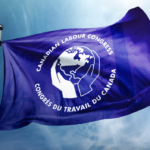On October 14, 1976 over a million workers walked off the job across Canada as part of a General Strike called by the Canadian Labour Congress to protest the federal government’s plans to impose wage and price control legislation – a broken campaign promise and betrayal of workers by the Trudeau Liberal government.
As Canada moved into the 1970s, workers faced difficult economic times. Work was changing with the early stages of globalization and automation. Workers were losing their jobs as employers adopted new technologies at home and shifted production to lower-paid workers overseas.
Inflation was on the rise along with that unemployment. The Canadian dollar lost its value and drastic increases in the price of oil, caused by Organization of Petroleum Exporting Countries (OPEC) export quotas, resulted in price shocks that hit consumers hard. Over the 1970s, the price for a barrel of oil jumped from $3 to $40, an increase of over 1300%.
To compensate, workers demanded higher wages while businesses accelerated plans to cut costs while raising prices to satisfy their need for profit. Unemployment and prices continued to rise, while the economy sputtered – a phenomenon economists and politicians labeled “stagflation”.
During the 1974 federal election campaign, the Conservative Party campaigned on a platform to impose legal caps on wages and prices. Seeking re‑election, the Liberal Party, led by Pierre Trudeau, openly ridiculed the idea and presented itself to Canadians as an anti-control party. Working people, fearing the loss of jobs and income, flocked to the Liberals, returning them to power with a majority government.
Just one year later, Trudeau broke his promise. Canadians were outraged.
Wage caps were imposed on workplaces with 500 or more employees, on all federal workers, and on most other public-sector employees. While inflation stood at nearly 11% in 1975, Trudeau’s law limited wage increases over the next three years to 8%, then 6%, and finally 4%. The attack on inflation was, in fact, an attack on workers’ wages as negotiated pay increases and collective agreements were rolled back.
The labour unrest caused by Trudeau’s betrayal resulted in over 11.6 million work days lost to strikes and lockouts in 1976 alone. The CLC, under the leadership of Joe Morris, called for a National Day of Protest on October 14th that resulted in the largest labour protest in the country’s history. Over a million Canadians took part – walking off the job, marching in the streets, and voicing their opposition to Trudeau’s unfairness.
Despite the sacrifice imposed on millions of Canadian workers, their families and their communities, inflation had declined by just 1.7% when wage-and-price controls ended in 1978. Trudeau’s Liberals were defeated in the next federal election.
Today, Canada’s unions continue to push back against unfairness. Government austerity – cuts to programs and services, wage and hiring freezes, privatization, the selling of public assets, etc. – shifts the burden onto those who can least afford to pay. “From each according to their means, to each according to their needs” remains the golden rule.

